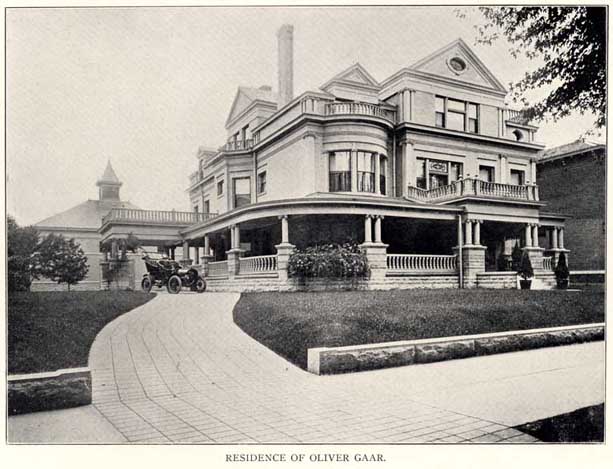Oliver Perry Gaar was my fifth cousin twice removed, son of the very wealthy Abram Gaar, president of Gaar, Scott Co., in Richmond, Indiana, manufacturers of threshing machinery and steam engines in the late 1800s. Oliver apparently never had to earn a living, as the census records state that he had his “own income.”
On February 18, 1880, Oliver married Mary Alice Huchinson, much to the dismay of his mother, Agnes: Mary Alice had been Agnes Gaar’s seamstress and so was felt to be beneath the Gaars’ high social standing. After all, as an heir to the family fortune, Oliver P. Gaar was one of the most eligible bachelors in his day, and at one time he was slated to marry a socialite. While he could have had his pick of any blue-blooded girl in Richmond, Indiana, his pick was Mary Alice Hutchinson, a working girl.
While traditionally Gaar family weddings were quite elaborate, Oliver married Mary Alice on February 18, 1880, in a quiet ceremony. After their marriage, the couple lived at his parents’ home until they could finish building their own. In 1881, Oliver and Mary Alice moved to an Italianate style home located at 302 N. 12th Street in Richmond, that was clearly designed as a visible statement that the new bride was equal to her position as a Gaar.

While the Gaar residences in Richmond, Indiana, were all stunning, this one clearly was a mansion. The exterior was of gray brick, with Ionic columns, dentils, pediments and other detailing in the Classical Revival style. On the interior, there were gold-washed lighting fixtures, silk wall coverings, painted or coffered ceilings, wainscoting, inlaid floors and Art Nouveau stained glass windows. A magnificent oak staircase led to the second floor. Some of the rooms had built-in marble lavatories. Every room in the home had a gas-burning fireplace, each one different from the others. A 2,000-square-foot ballroom on the third floor would accommodate any of the dances of the period held in Richmond, Indiana. There were quarters for live-in servants, and a call box/intercom system and dumb waiter aided in the smooth provision of services to the owners. A porte-cochere on the side entrance allowed a horse and carriage or car to pass under to allow its occupants to exit to the home without encountering any inclement weather. A two-story carriage house was situated behind the residence.
One time, Oliver crossed the street to look at his home with all the lights on. When asked what he was doing, he replied, “I just wanted to see what the whole damn thing looks like lit up at night!”
Oliver and Mary Alice Gaar had one child, a daughter named Mary Agnes, named for her mother, Mary Alice, and her grandmother, Agnes Adams Gaar. Some say that it was through this daughter that Oliver’s mother perhaps had the last say regarding the marriage of her first-born, 23 years before, a match which she felt was beneath him.
The Indianapolis Morning Star of July 20, 1903, tells the story:
SOCIETY GIRL WEDS SECRETLY
Agnes Gaar, of Richmond, Announces
She Has Been Married Since May.
EFFORTS OF PARENTS TO PREVENT
CEREMONY FAIL
Young Couple Used License Procured for
an Earlier Marriage Which
Did Not Take Place.A sensation was created in Richmond society by the announcement that Richard Study, son of attorney Thomas J. Study, and Miss Agnes Garr, daughter of Oliver Garr, both society leaders, were married secretly on May 4. The marriage was kept secret until last night, when the young couple left quietly for Petoskey, Mich., and then told their parents.
The bride is nineteen years old and is heiress to a large fortune. The home of her parents is the most palatial in Richmond. Mr. Study had been paying his attentions to the young lady for a long time, despite the objections of the girl’s parents. Miss Garr had promised to marry Study, but when the consent of her parents was asked the girl was met with a refusal.
In spite of their efforts to prevent it, Mr. Study continued to pay his attentions and the young couple last January prepared to marry, notwithstanding the difficulties which they encountered. One evening just before the office of the county clerk was closed, a marriage license was issued to them.
Just why the ceremony did not take place at that time has never been told, but it is said that at the last minute the bride-to-be weakened and confessed to her parents what had been planned.
Young Study was disappointed, but kept the license. Mr. and Mrs. Garr sent their daughter to Palm Beach, Fla., and she spent the balance of the winter there, but absence only increased the affection between the two, and upon her return their marriage was again planned. Miss Garr confided her story to her grandmother and enlisted her sympathy. It was arranged that they should be married at the grandmother’s home, and on May 4 the ceremony was performed. The bride returned to her home and remained until last night with her parents, who were totally unconscious of what had occurred. Last night Mr. Study and his bride boarded the Northland express on the G.R.&I., and it was not until they were speeding northward that her parents learned of the marriage. Her mother is prostrated.
Oliver and Mary Alice were married for 45 years; he died in 1923 and she died in 1945. After Oliver’s death, his wife sold the home to Deskin Jones and Elmer Plack, who operated it as a very successful funeral home. In the early 2000s it became a salon and day spa. It is now a special events venue and home of Queen Bee Confections.
Their daughter, Mary Agnes, and Richard Study were married for 40 years. She died of cancer in 1942, aged 57, and he died the following year at the age of 63. They had no children.
Great story. Enjoyed reading your post today.
LikeLike